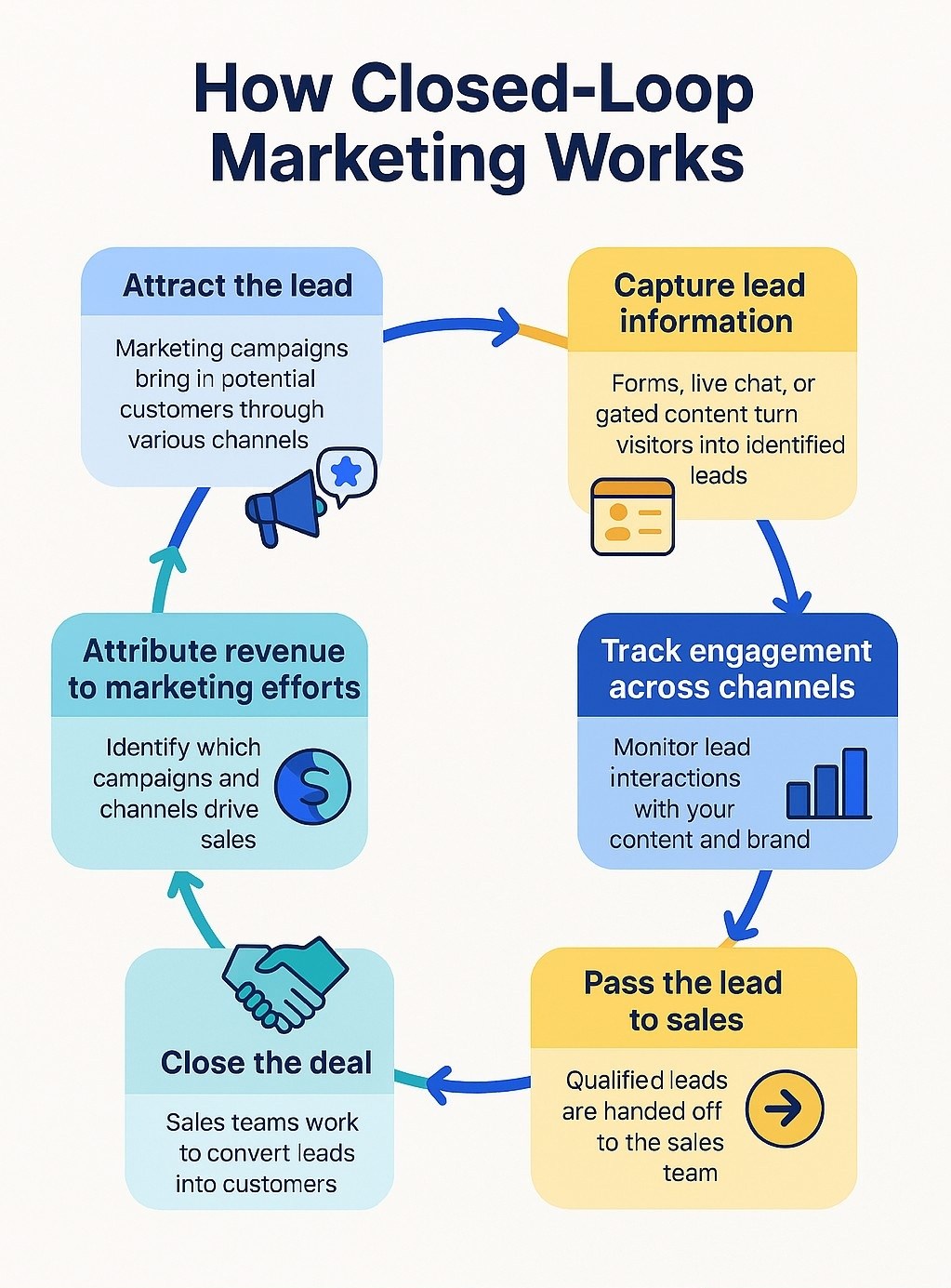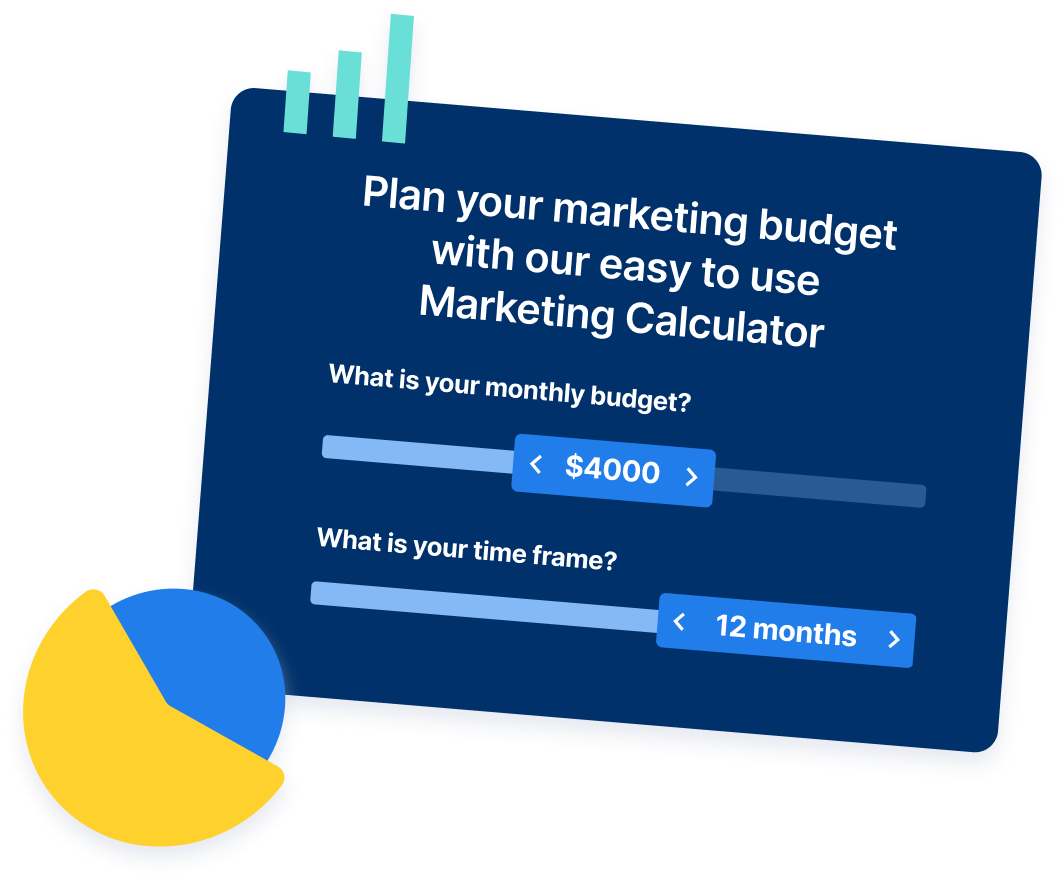-
 Published: Apr 3, 2025
Published: Apr 3, 2025
-
 6 min. read
6 min. read
-
 Emily Carter, M.S.
Emily Carter, M.S. Sr. Content Team Lead
Sr. Content Team Lead
- Emily leads the FX content team, along with strategy, implementation, and evaluation for WebFX’s key revenue channels. She holds an M.S. in digital marketing, and her work has been featured by Social Media Today, Campaign Monitor, Reader’s Digest, and more. In her free time, she enjoys hiking, road trips, and exploring new cities. @emcarter16
If you’re struggling to prove your marketing ROI, you’re not alone — 63% of marketers say they can’t confidently measure how their campaigns impact revenue.
When you’re investing time and budget into marketing, not knowing what’s actually working can feel like flying blind. That’s where closed-loop marketing comes in. Also known as closed-loop attribution or reporting, it helps you connect the dots between your marketing efforts and real sales results.
Keep reading to see how it works — and how it can help you turn guesswork into growth.
What is closed-loop marketing?
Closed-Loop Marketing Defined:
Closed-loop marketing is a strategy that tracks and analyzes customer data from initial interaction to final sale, allowing businesses to tie marketing efforts directly to revenue outcomes.
🎥 Video: Closed-loop marketing for beginners
5 benefits of closed-loop marketing (when you’re tired of not knowing what’s working)
- Clear ROI Attribution: Know exactly which campaigns, channels, or content pieces are generating revenue — no more guesswork.
- Smarter Budget Allocation: Stop wasting spend on underperforming tactics and double down on what’s driving real results.
- Better Sales and Marketing Alignment: Create a shared view of what a qualified lead looks like and how to move them from interest to close.
- Shorter Sales Cycles: Use data from marketing interactions to help sales reps personalize outreach and close deals faster.
- Continuous Campaign Optimization: Get real feedback from closed deals to improve targeting, messaging, and strategy over time.
How closed-loop marketing works

Closed-loop marketing connects the dots between your marketing efforts and actual sales outcomes.
Here’s a simple breakdown of how it works — from first interaction to attributing revenue — so you can finally see what’s driving real results.
1. Attract the lead
Your marketing campaigns bring in potential customers through a variety of channels — from organic search and paid ads to social media and email. Each of these touchpoints plays a role in introducing your brand and encouraging users to take the next step. The key here is to make sure every click and visit is tracked from the start.
💡 How to do it & tools to use:
Use tools like Google Analytics 4, UTM parameters, and ad platform tracking pixels (Google Ads, Meta, LinkedIn) to monitor where your traffic is coming from and which channels perform best.
2. Capture lead information
Once visitors land on your site and engage with your content, the goal is to capture their information — usually through a form, live chat, or gated content download. This is the point where anonymous traffic becomes a known lead, and tracking can start tying actions to a real person.
💡 How to do it & tools to use:
Use CRM-integrated forms, lead capture pop-ups, or landing page tools like Unbounce to collect info and tag the lead source automatically.
3. Track engagement across channels
After capturing lead data, it’s critical to keep tracking how that lead interacts with your brand — what pages they visit, emails they open, events they attend, etc. This full-funnel visibility helps you understand what content drives deeper interest and helps sales teams personalize follow-ups.
4. Pass the lead to sales
Once a lead reaches a certain qualification threshold — like downloading a pricing guide or requesting a demo — they’re handed off to the sales team. This stage is crucial for maintaining continuity in the buyer journey and ensuring sales knows where the lead came from and what they’ve interacted with.
💡 How to do it & tools to use:
Automate lead handoff, and make sure your CRM is synced with your marketing platform for seamless data flow. Use lead scoring models to identify sales-ready contacts.
5. Close the deal
After nurturing and conversations, the sales team closes the deal. When that happens, the system logs the sale and attaches it to the contact record — along with deal size, timeline, and sales rep details — closing the loop from initial touch to final transaction.
💡 How to do it & tools to use:
Use CRM platforms like Nutshell or HubSpot to log closed deals, and connect them to your marketing platform via native integrations or tools like Zapier. This ensures you can trace the revenue back to the originating campaign.
6. Attribute revenue to marketing efforts
With marketing and sales data connected, you can finally see which campaigns, channels, or even specific keywords contributed to the sale. This insight lets you double down on what works and cut what doesn’t — leading to smarter marketing decisions and higher ROI.
💡How to do it & tools to use:
Use closed-loop attribution features in your CRM and platforms like Marketo or Google Analytics 4 (with CRM integration). BI tools like Tableau, Looker, or Google Data Studio can visualize performance across channels and campaigns.
5 tips for aligning sales, marketing, & tech for closed-loop success
On paper, closed-loop marketing seems straightforward. But in practice, it only works when your tech stack is connected and your marketing and sales teams are aligned around shared goals, data, and processes.
Here are some actionable tips to help your teams (and tools) work together seamlessly:
1. Get sales and marketing on the same page
Start with shared definitions of what counts as a lead, what qualifies them for sales, and what success looks like. Set joint KPIs like marketing-influenced revenue or lead-to-close rate to keep everyone focused on the same outcome.
💡 Tip: Facilitate regular sales-marketing syncs to review lead quality, campaign performance, and feedback loops.
2. Audit and integrate your tech stack
Your CRM, marketing automation, analytics tools, and ad platforms need to talk to each other. If your tools aren’t connected, your data will be too fragmented to close the loop effectively.
💡 Tip: Use platforms with native integrations or middleware tools like Zapier or Make to sync data across systems.
3. Standardize lead source tracking
Make sure your lead source and campaign tracking is consistent across platforms. UTM parameters, campaign IDs, and consistent naming conventions are key to accurately attributing revenue later.
💡 Tip: Build a UTM builder template and enforce its use across all campaigns to ensure clean data.
4. Implement lead scoring and qualification criteria
Not every lead is ready for sales — and that’s okay. Use lead scoring to prioritize high-intent contacts and prevent sales from wasting time on unqualified leads.
💡 Tip: Align on scoring rules that reflect buying signals like pricing page views, demo requests, or high email engagement.
5. Close the feedback loop
Once a lead is passed to sales, marketers need to know what happens next — and why. Wins and losses both provide valuable data for refining targeting, messaging, and strategy.
💡 Tip: Use your CRM to track deal outcomes and tag closed deals back to the originating campaign. Set up dashboards to monitor performance by source.
FAQs: Making sense of closed-loop marketing
What is closed-loop marketing?
Closed-loop marketing is a strategy that integrates data from marketing and sales teams to track and analyze customer interactions from initial contact to final sale. This approach helps businesses understand which marketing efforts lead to revenue, enabling more informed decisions and improved return on investment (ROI).
How does closed-loop marketing work?
It involves collecting data at each stage of the customer journey, from the first touchpoint through to the sale. By using tools like Customer Relationship Management (CRM) systems and marketing automation platforms, businesses can monitor customer behaviors, attribute sales to specific marketing campaigns, and continuously refine their strategies based on these insights.
Why is closed-loop marketing important?
This approach allows businesses to directly link marketing activities to sales outcomes, providing clear insights into what strategies are effective. It enhances accountability, optimizes marketing spend, and fosters better alignment between marketing and sales teams, ultimately leading to increased efficiency and profitability.
What tools are essential for implementing closed-loop marketing?
Key tools include CRM systems to track customer interactions, marketing automation platforms to manage campaigns, and analytics tools like GA4 to assess performance. Integrating these tools ensures seamless data flow and comprehensive analysis.
What challenges might arise when adopting closed-loop marketing?
Common challenges include integrating disparate systems, ensuring data accuracy, and fostering collaboration between marketing and sales teams. Addressing these issues requires careful planning, investment in compatible technologies, and promoting a culture of open communication and shared goals within the organization.
Unlock the full value of your marketing with closed-loop insights from WebFX
Still struggling to connect your marketing efforts to real revenue? Whether you’re not sure how to set up closed-loop reporting or you’re tired of flying blind with unclear ROI, WebFX is here to help you close the gap.
As a leading digital marketing agency, we specialize in strategies that don’t just get clicks — they drive revenue. And with our proprietary tool, RevenueCloudFX, we make it easy to track every dollar back to its source.
From SEO to paid media and beyond, our team integrates your CRM and marketing platforms to give you crystal-clear visibility into what’s working — and what’s not. That means smarter decisions, better results, and real growth.
Connect with a WebFX expert to learn how our closed-loop marketing solutions can turn your data into ROI.
-
 Emily leads the FX content team, along with strategy, implementation, and evaluation for WebFX’s key revenue channels. She holds an M.S. in digital marketing, and her work has been featured by Social Media Today, Campaign Monitor, Reader’s Digest, and more. In her free time, she enjoys hiking, road trips, and exploring new cities.@emcarter16
Emily leads the FX content team, along with strategy, implementation, and evaluation for WebFX’s key revenue channels. She holds an M.S. in digital marketing, and her work has been featured by Social Media Today, Campaign Monitor, Reader’s Digest, and more. In her free time, she enjoys hiking, road trips, and exploring new cities.@emcarter16 -

WebFX is a full-service marketing agency with 1,100+ client reviews and a 4.9-star rating on Clutch! Find out how our expert team and revenue-accelerating tech can drive results for you! Learn more
Try our free Marketing Calculator
Craft a tailored online marketing strategy! Utilize our free Internet marketing calculator for a custom plan based on your location, reach, timeframe, and budget.
Plan Your Marketing Budget
Table of Contents
- What is Closed-loop Marketing?
- 🎥 Video: Closed-loop Marketing for Beginners
- 5 Benefits of Closed-loop Marketing (when You’re Tired of Not Knowing What’s Working)
- How Closed-loop Marketing Works
- 1. Attract the Lead
- 2. Capture Lead Information
- 3. Track Engagement Across Channels
- 4. Pass the Lead to Sales
- 5. Close the Deal
- 6. Attribute Revenue to Marketing Efforts
- 5 Tips for Aligning Sales, Marketing, & Tech for Closed-loop Success
- Unlock the Full Value of Your Marketing with Closed-loop Insights from WebFX

Proven Marketing Strategies

Proven Marketing Strategies
Try our free Marketing Calculator
Craft a tailored online marketing strategy! Utilize our free Internet marketing calculator for a custom plan based on your location, reach, timeframe, and budget.
Plan Your Marketing Budget





